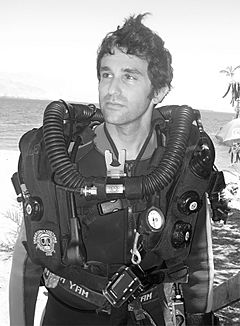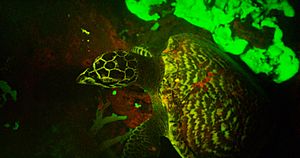David Gruber facts for kids
Quick facts for kids
David Gruber
|
|
|---|---|
 |
|
| Born |
Paterson, New Jersey, US
|
| Citizenship | United States |
| Alma mater | Rutgers University (PhD) Columbia University (MS) Duke University (MEM) University of Rhode Island (BS) |
| Awards | Lagrange Prize |
| Scientific career | |
| Fields | Marine Biology |
| Institutions | Baruch College Harvard University American Museum of Natural History |
David Gruber is an American marine biologist. He is a professor of Biology and Environmental Sciences at Baruch College in New York City. He is also a National Geographic Explorer, which means he explores and studies the world for National Geographic.
Contents
Early Life and Education
David Gruber was born in Paterson, New Jersey. He studied at several universities to become the scientist he is today. He earned his first degree from the University of Rhode Island. He then got a master's degree in journalism from Columbia University. He also earned a master's degree in environmental management from Duke University. Finally, he received his PhD in Biological Oceanography from Rutgers University. After his PhD, he did more research at Brown University.
In 2017 and 2018, David was a special researcher at Harvard University. He is also connected with the Yale School of Medicine.
Discoveries in the Ocean
David Gruber is famous for finding many amazing things in the ocean. In 2014, he and his team discovered over 180 new types of fluorescent fish. These fish can glow in the dark! This discovery was even written about in The New York Times.
In 2015, he saw something incredible: a Hawksbill sea turtle that glowed. This was the first time anyone had seen a marine reptile that could glow. National Geographic showed videos of this exciting discovery. David also gave a TED Talk about glowing sea creatures. Millions of people have watched it. National Geographic later called this discovery one of the "top 20 scientific discoveries of the decade."
In 2016, David and his team created a special "shark-eye" camera. This camera helped scientists see how sharks look to each other. Videos from this camera were also shown on the National Geographic website.
From 2017 to 2018, David spent time studying jellyfish. He learned about how they glow and how they are affected by climate change. He used this research to create an educational animation for TED-ed. In 2018, he also helped National Geographic Kids with their series called "Best Job Ever," sharing how cool marine biology is.
In 2019, David's team found out why some sharks glow. It's because of special chemicals in their skin. This discovery was featured in many places, including The New York Times and Science Magazine. That same year, David and his team also discovered that flashlight fish swim together in groups at night. They use their bioluminescent organs (which make light) to see each other. This discovery suggests that even deep-sea fish might swim in schools.
David also led the first study to use advanced machine learning to understand Sperm Whale sounds. He now leads a big project called Project CETI. This project aims to understand how Sperm Whales communicate with each other.
Gentle Ocean Exploration
Since 2015, David Gruber has worked with scientists at Harvard University. They are creating gentle robots to explore the ocean. These robots can pick up delicate sea creatures like jellyfish without hurting them. They have developed "Squishy Robot Fingers" and an "Origami Robot." They also made soft robotic arms for submarines. These tools help marine researchers study fragile animals safely.
Their work was even shown in an exhibit at the American Museum of Natural History called Unseen Oceans.
Awards and Recognition
David Gruber has received several awards for his important work:
- 2019: He won the Lagrange Prize from Italy.
- 2016: He was a main speaker at the Explorers Club Annual Dinner.
- 2014: He became a Fellow of the Explorers Club.
- 2014: He was named an "Emerging Explorer" by the National Geographic Society.
- 2006: His article in The New Yorker was chosen for "Best American Science Writing."
Art Collaborations
David Gruber has also worked with artists to share the beauty of the ocean:
- He collaborated with Joan Jonas on an art project called "Moving off the Land II."
- He worked with Janaina Tschäpe on "Fictionary of Corals and Jellies."
Images for kids



